Environmental Exposures Linked to Compromised Health
Summary
In a new study scientists analyzed five toxic metals of hydrogeological origin and association with heart disease, coronary heart disease, and stroke.
Environmental Exposures Linked to Compromised Health
Important Considerations for Effective Detox Support
In a new study published in BMJ, scientists analyzed five toxic metals of “hydrogeological origin” (of the groundwater in the soil and rocks of the Earth’s crust) and their association with risk of cardiovascular disease, coronary heart disease, and stroke:
- Arsenic
- Lead
- Cadmium
- Mercury
- Copper
Scientific evidence has already placed these toxic metals in the context of cancer risk and labeled them as immunotoxicants, but their association with increased risk of heart disease has yet to be characterized in detail (although copper has been shown to increase the risk of atherosclerosis by enhancing oxidation of LDL cholesterol).
A comprehensive systematic review and meta-analysis resulted in two major conclusions:
- Arsenic, lead, cadmium, and copper are associated with an increased risk of cardiovascular disease and coronary heart disease
- Mercury is not associated with cardiovascular disease
Read about what detoxification can do for the human body.

Chowdhury, R., Ramond, A., O’Keeffe, L., Shahzad, S., Kunutsor, S., Muka, T., et al. (2018). Environmental toxic metal contaminants and risk of cardiovascular disease: systematic review and meta-analysis BMJ; 362 :k3310







